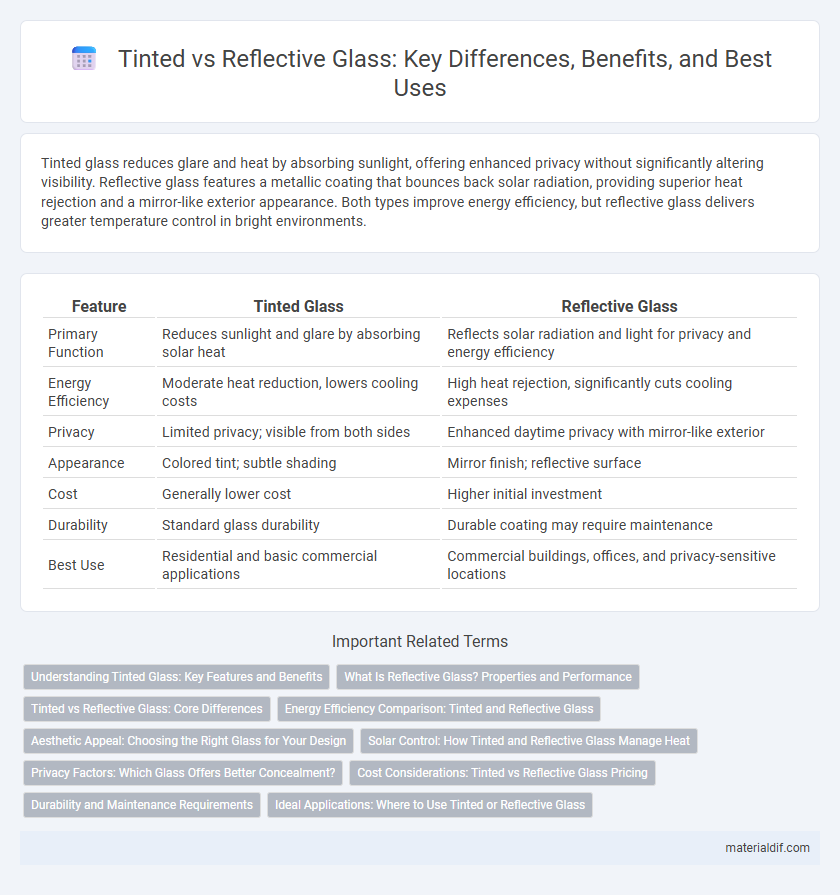Tinted glass reduces glare and heat by absorbing sunlight, offering enhanced privacy without significantly altering visibility. Reflective glass features a metallic coating that bounces back solar radiation, providing superior heat rejection and a mirror-like exterior appearance. Both types improve energy efficiency, but reflective glass delivers greater temperature control in bright environments.
Table of Comparison
| Feature | Tinted Glass | Reflective Glass |
|---|---|---|
| Primary Function | Reduces sunlight and glare by absorbing solar heat | Reflects solar radiation and light for privacy and energy efficiency |
| Energy Efficiency | Moderate heat reduction, lowers cooling costs | High heat rejection, significantly cuts cooling expenses |
| Privacy | Limited privacy; visible from both sides | Enhanced daytime privacy with mirror-like exterior |
| Appearance | Colored tint; subtle shading | Mirror finish; reflective surface |
| Cost | Generally lower cost | Higher initial investment |
| Durability | Standard glass durability | Durable coating may require maintenance |
| Best Use | Residential and basic commercial applications | Commercial buildings, offices, and privacy-sensitive locations |
Understanding Tinted Glass: Key Features and Benefits
Tinted glass reduces solar heat gain by absorbing a portion of sunlight, improving energy efficiency and reducing cooling costs in buildings and vehicles. Its varying degrees of color help control glare while maintaining natural light transmission, enhancing visual comfort and privacy. Commonly used in architectural and automotive applications, tinted glass also protects interiors from UV damage and contributes to aesthetic appeal.
What Is Reflective Glass? Properties and Performance
Reflective glass features a metallic coating applied to one surface, designed to reduce solar heat gain and glare by reflecting a significant portion of sunlight. Its high solar reflectance enhances energy efficiency, making it ideal for commercial buildings aiming to lower cooling costs while maintaining natural daylight. This glass type also provides daytime privacy without compromising external visibility, offering superior performance in controlling light and temperature compared to tinted glass.
Tinted vs Reflective Glass: Core Differences
Tinted glass reduces solar heat gain by absorbing sunlight, providing energy efficiency and glare reduction without significantly altering external reflections. Reflective glass uses a metallic coating to reflect solar radiation, enhancing privacy and reducing heat while creating a mirror-like appearance from the outside. The core difference lies in their light control methods--tinted glass absorbs light whereas reflective glass reflects light.
Energy Efficiency Comparison: Tinted and Reflective Glass
Tinted glass reduces solar heat gain by absorbing and diffusing sunlight, lowering indoor temperatures and decreasing cooling costs. Reflective glass uses a metallic coating to reflect a significant portion of solar radiation, offering superior protection against heat buildup while maintaining natural daylight. Both types improve energy efficiency, but reflective glass typically achieves higher thermal performance and glare reduction in commercial and residential buildings.
Aesthetic Appeal: Choosing the Right Glass for Your Design
Tinted glass offers a subtle color variation that enhances the overall aesthetic by reducing glare and creating a warm, inviting ambiance, making it ideal for modern and cozy interior designs. Reflective glass provides a mirror-like finish that adds a sleek, contemporary look while maximizing privacy and controlling solar heat gain. Selecting between tinted and reflective glass depends on the desired visual impact and functional benefits, balancing style with energy efficiency and privacy needs.
Solar Control: How Tinted and Reflective Glass Manage Heat
Tinted glass reduces solar heat by absorbing a portion of the sunlight, thereby lowering indoor temperatures and minimizing glare, which enhances energy efficiency in buildings. Reflective glass manages heat by reflecting a significant amount of solar radiation away from the surface, significantly decreasing cooling loads and improving occupant comfort. Both types of glass contribute to solar control but vary in their mechanism--tinted glass absorbs heat while reflective glass deflects it, impacting thermal performance and aesthetics differently.
Privacy Factors: Which Glass Offers Better Concealment?
Tinted glass reduces visibility by darkening the view through the glass, offering moderate privacy by limiting brightness and glare, while reflective glass employs a mirror-like surface that significantly enhances concealment during daylight hours by reflecting external surroundings. Privacy factors favor reflective glass for superior one-way visibility, especially in environments requiring stricter concealment, but its effectiveness diminishes at night without external lighting adjustments. Selecting between tinted and reflective glass depends on balancing privacy needs with aesthetics and lighting conditions.
Cost Considerations: Tinted vs Reflective Glass Pricing
Tinted glass generally has lower upfront costs compared to reflective glass due to simpler manufacturing processes and fewer special coatings. Reflective glass, with its metallic coatings designed to reduce glare and heat, incurs higher production expenses that translate to increased pricing. Choosing between tinted and reflective glass depends on budget constraints and desired energy efficiency benefits, where reflective glass often offers better long-term savings despite higher initial investment.
Durability and Maintenance Requirements
Tinted glass offers enhanced durability by filtering UV rays and reducing heat absorption, which minimizes fading and structural stress. Reflective glass provides superior resistance to environmental damage due to its metallic coatings, requiring less frequent cleaning and maintenance. Both types demand routine upkeep, but reflective glass typically requires fewer interventions due to its higher resistance to dirt and weathering effects.
Ideal Applications: Where to Use Tinted or Reflective Glass
Tinted glass is ideal for residential windows and automotive applications, providing effective heat reduction and UV protection while enhancing privacy without compromising natural light. Reflective glass suits commercial buildings and high-rise structures where glare control and energy efficiency are paramount, creating a mirror-like surface that reflects solar radiation. Both types optimize energy savings and occupant comfort based on specific environmental and aesthetic requirements.
Tinted vs Reflective Infographic

 materialdif.com
materialdif.com